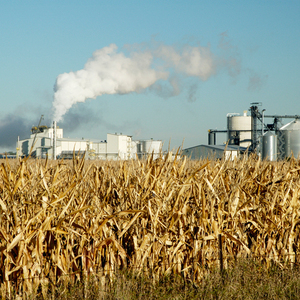Proposed low-carbon fertilizer project could benefit ethanol producers

July 21, 2023
The U.S. EPA on July 7 opened a public comment period on its intent to issue Class VI permits for a carbon capture and storage (CCS) project that would sequester CO2 produced at a proposed fertilizer production facility. Project developers say the resulting low-carbon fertilizer could help lower the carbon intensity (CI) of corn and ethanol.
Wabash Valley Resources is developing the proposed project in West Terre Haute, Indiana, with the aim of producing low-carbon anhydrous ammonia fertilizer.
The project site was originally home to a pulverized coal power plant that was developed in the 1950s. With the support from the U.S. Department of Energy’s Clean Coal Technology program, a portion of the facility was converted into a coal gasification plant in the 1990s. That gasification project, owned by SG Solutions, operated until mid-2016.
Advertisement
WVR was established in 2016 to acquire the idle SG Solutions gasification plant. The company plans to redevelop the site, integrating anhydrous production and a CCS project with the existing gasification and power generation facility.
Greg Zoeller, vice president of external affairs at WVR, explains that the gasification plant can take in any type of carbon-based feedstock. Currently, the company is targeting the use of petroleum coke (petcoke), a byproduct of oil refining, as feedstock rather than coal. The company is also investigating the possibility of processing locally available agricultural waste as feedstock, particularly corn cobs.
Advertisement
Hydrogen produced via the gasification process would be used as an input for anhydrous ammonia production, while carbon dioxide produced at the facility would be captured and stored underground, according to Zoeller. Integrating CCS with the project will enable the production of low-carbon anhydrous ammonia fertilizer. Farmers who use the fertilizer will lower the CI of their corn crops, enabling lower CI ethanol production. The use of biomass feedstock would provide even more significant CI reductions.
The proposed facility is currently expected to produce 500,000 metric tons of anhydrous ammonia annually, which WVR says is equal to a significant portion of current annual usage within the Eastern Corn Belt. WVR currently aims to have the project operational by 2026, but Zoeller cautions that timeline is dependent on a wide variety of factors, including permitting.
The EPA’s July 7 announcement that it intends to issue two Class VI permits for the project represents an important step forward in the overall project. “The carbon storage permits are an important milestone that brings the United States closer to industrial-scale, domestic, environmentally friendly ammonia production and moves America's farmers closer to fertilizer independence,” Zoeller said. "The EPA's issuance of the two draft Class VI permits for carbon storage validates our investment to date and our more than five years of research and testing to verify the geology of the injection well sites as suitable for permanent carbon sequestration."
According to EPA documents, the project would inject an estimated 1.67 million metric tons of carbon dioxide per year into the two Class VI wells over a period of 12 years. The EPA is accepting public comments on the proposed Class VI permits through Aug. 11. Additional information is available on the EPA’s website.
Related Stories
The USDA significantly increased its estimate for 2025-’26 soybean oil use in biofuel production in its latest World Agricultural Supply and Demand Estimates report, released July 11. The outlook for soybean production was revised down.
U.S. fuel ethanol capacity fell slightly in April, while biodiesel and renewable diesel capacity held steady, according to data released by the U.S. EIA on June 30. Feedstock consumption was down when compared to the previous month.
The U.S. EPA on July 8 hosted virtual public hearing to gather input on the agency’s recently released proposed rule to set 2026 and 2027 RFS RVOs. Members of the biofuel industry were among those to offer testimony during the event.
The USDA’s Risk Management Agency is implementing multiple changes to the Camelina pilot insurance program for the 2026 and succeeding crop years. The changes will expand coverage options and provide greater flexibility for producers.
The USDA’s National Agricultural Statistics Service on June 30 released its annual Acreage report, estimating that 83.4 million acres of soybeans have been planted in the U.S. this year, down 4% when compared to 2024.
Upcoming Events










